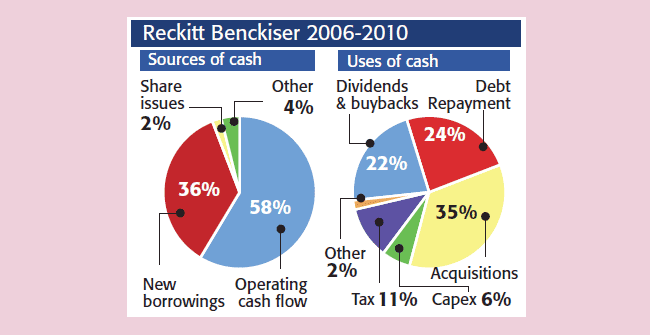
Equity investing is all about cash. We invest in shares and expect a cash return in the form of dividends and eventual sale proceeds. Yet companies often don’t talk much about cash – they prefer you to focus on profit related measures such as earnings per share (EPS). So here I reveal how to use the cash-flow statement to help you select the best investments.
What’s wrong with profit?
Profit, and profit-based measures such as EPS and price-to-earnings (p/e) ratios, can mislead investors. Thanks to what accountants call the ‘accruals’ concept, there are many subjective estimates involved.
Free cash flow is best
The appeal of free cash flow (FCF) is its simplicity. It calculates the amount of cash left over to a firm after all non-discretionary cash expenditures. As an investor, it makes sense to buy firms with lots of surplus or FCF. Without FCF, a firm can’t pay dividends, repay debt or buy back shares. In short, it can’t provide a sustainable return on your investment. The investing world is full of stocks that generate profits but little or no FCF. These tend to be bad investments. There is unfortunately no universal definition of FCF, but here’s a good way to calculate it from a company’s cash-flow statement.
Applying FCF to Reckitt Benckiser
Let’s take the 2010 cash-flow statement of Reckitt Benckiser (RB.L) to reveal how to calculate FCF. In 2010, Reckitt Benckiser (RB) generated £1,219m of free cash flow. That’s made up of operating cash flow (£2,215m) plus interest receivable (£19m), less interest payable (£11m), less tax paid (£679m), less purchases of fixed assets (£367m), plus sale proceeds from fixed assets (£42m). Such a large amount of FCF is a good start, but what does it mean? Here is how the number can be applied to weigh up an investment.
FCF per share
This is arrived at by dividing annual FCF by the weighted average number of shares outstanding. In 2010 this was £1219m/724.2m = 168.3p per share. This was 78% of the reported EPS of 216.5p. If FCF per share is consistently below the EPS it could be a sign of aggressive accounting that needs investigating. The difference in RB’s figures was due to capital expenditure being more than twice its depreciation charge. Eventually, capital expenditure has to generate a cash return. During the last five years, RB’s FCF has consistently been higher than its EPS – a hallmark of a quality company. Free cash dividend cover This is the FCF divided by dividends paid. In 2010, RB’s free cash dividend cover was a very comfortable 1.6 times. Investors should avoid firms where free cash dividend cover is below one times, as this is often the sign of an unsustainable dividend policy.
Free cash margin
This measure – FCF/sales – looks at the ability of a company to turn its sales into cash for shareholders. In 2010, RB converted 14.4% of its sales into FCF, despite investing heavily. The average is around 17% over the last five years, indicating that RB produces good financial returns.
Free cash-flow yield
FCF per share/share price can be used as a valuation measure to compare shares with other investments. RB’s current yield of 5.3% (168.3/3195p) is not particularly high, suggesting the shares are not an obvious bargain. Value investors often buy shares with FCF yields of 10% or more.
Sources and uses of cash
The cash-flow statement gives an insight into where a firm gets its cash from and what it does with it. This is best looked at over a number of years (see pie charts).
Over half of RB’s cash is derived from its operating cash flow – a good sign as long as it is sustainable. Be wary of companies that are overly reliant on new borrowings and equity finance as sources of cash: at some point they will run out!
RB has spent a lot of its cash on acquisitions. That’s fine if it produces acceptable cash returns, but may also serve as a warning sign. The company does not use a lot of cash to buy new assets (capital expenditure) and distributes nearly one quarter of its cash to shareholders.
A stock to buy and one to avoid
Microsoft ( MSFT
) generated $24.6bn of free cash flow during its last financial year, equivalent to an impressive 35% of revenues. Free cash flow per share of $2.90 was greater than reported EPS of $2.73, resulting in a chunky free cash-flow yield of 11.6% at a share price of $25.
United Utilities ( UU.L
) with its 5.3% dividend yield will be seen by many as a defensive share. However, it only generated £89.6m of free cash flow during its last financial year, equivalent to 13.1p per share. This compares with an EPS of 52.1p and a dividend of 30p per share. Judging from this, it seems that United could be borrowing to pay its dividend – if true that’s not a good sign for investors.